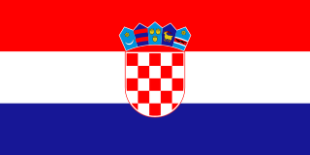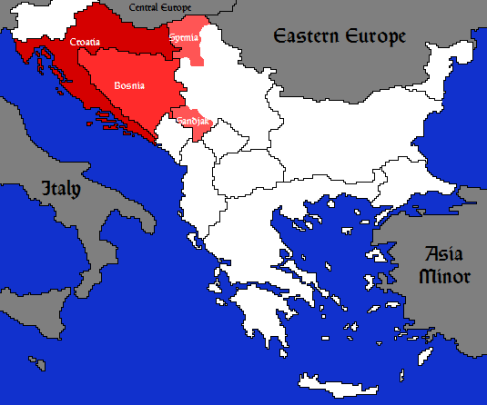Greater Croatia (Velika Hrvatska)
The concept of a Greater Croatia has its origins in the Illyrian movement, which sought to create a pan-south slavic state within the borders of the Habsburg Empire. The movement was created as a response to the Magyarization of the Croatia, located within the borders of the Hungarian part of the Kingdom. Many people wanted to create a Croatian autonomous entity within the Habsburg Empire, including Dalmatia, then under Austrian control.
The Nationalist Party of Rights (1861) opposed the unification between Croatia and Serbia, preferring instead an Independent Croatia. As this Ideology gained popularity, the psyche of the Croatian would gradually change.
A’ight, you know the drill. Territories claimed by Croatian Irredentists are marked in shades of Red.
Tensions first started to rise in the 1930, as a response, the Yugoslavian Government created in the Cvetkovic–Macek Agreement, an unified Banovina (Yugoslavian province) of Croatia, including Dalmatia, Slavonia and small parts of the territory of Bosnia (According to the late Ottoman-era boundaries).
This agreement didn’t avoid the tragedy, however. Meanwhile in Italy, since 1927, the Ustasha (Fascist party created in 1921) and the Italian fascist government were already discussing the future boundaries of a future fascist Croat state. Mussolini would get a few enclaves in the dalmatian coast, including most of the islands, while Croatia would annex the entire Bosnia, as well as the Northern part of serbia (Syrmia).
These agreements came into reality after the Invasion of Yugoslavia. The new Croatian state would face opposition from Cetniks and Communists from all ethnicites. After the fall of Fascist Italy, Ustasha got the Italian areas of Dalmatia back, as the Mussolini-ruled breakaway republican state in the north had as its only concern its survival.
These small gains would be insignificants compared to the outbreak of the war. The Ustasha party was extinguished from the face of the earth as Yugoslavia was now a communist state. The new croatian republic withing Yugoslavia did not have bosnia, but it got Istria, a peninsula once under italian control.
In the 1990’s the Yugoslav wars broke out as a response to the declarations of independence issued by Slovenia, Macedonia (FYROM), Croatian and Bosnia and Herzegovina, the two latter being attacked by Serbian forces under Miloshevic. Despite teaming up with the Bosniaks, Croatia still wanted to annex some parts of this Bosnian cake. A partition of Bosnia was secured under the Karadjordjevo Agreement (1991) and the Graz Agreement (1992) by both Slobodan Miloshevic and Franjo Tudman. That led to a Croat-Bosnian war (Ended in 1994 with the Washington Agreement).
After Tudman’s death, his succesor, Stjepan Mesic, revealed thousands of documents and tabes about Tudman’s plans to expand Croatia’s borders at the expanse of Bosnia. Tudman once told an official: Let’s make a deal with the Serbs. Neither history nor emotion in the Balkans will permit multinationalism. We have to give up on the illusion of the last eight years… Dayton isn’t working. Nobody- except diplomats and petty officials – believes in a sovereign Bosnia and the Dayton accords.

